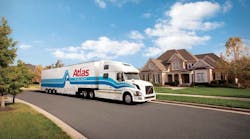Getting consensus in Washington often is difficult, but one issue that both parties and all stakeholders agree upon is that our roads are in poor condition, congestion is worsening and the trucking industry as well as the general driving public are fed up. Unfortunately, that's where the agreement stops. How to pay for the necessary infrastructure upgrades is a problem with no widely-accepted solution.
The problem is massive. According to a 2005 study by Cambridge Systematics for the U.S. Chamber of Commerce, just maintaining current roads and bridges (in 2005) would cost about $176-billion annually, $38-billion more than was available. The figure would be even higher today due to the higher cost of materials. And to actually improve roads, by 2015 the cost would be more than $214-billion annually.
A survey of the most discussed funding sources includes increasing the federal motor fuel tax, tolling, privatization of public roads, sales taxes, bonds and various combinations of these.
“We know we'll have to pay more in the future [for infrastructure building],” says Larry Davis, president of the Ohio Trucking Assn. “But we don't know how yet.”
Like many other truck stakeholders, Davis does not like the privatization option because the public and groups like his lose lobbying power in the state legislatures over toll increases once the roads become private. Indeed, drivers on some private roads have seen steep increases recently, including on the Virginia Greenway, which is expected to increase tolls July 1, 2007, resulting in a 25% rise since 2004. The owners are seeking more increases by 2011.
At a recent Congressional hearing on privatization, Todd Spencer, exec. vp of the Owner-Operator Independent Drivers Assn. , noted: “Governor Mitch Daniels signed over control of the Indiana Toll Road and its toll rates for the next 75 years, leaving governors who are yet to be born without any say …over that road.” American Trucking Assns. president Bill Graves testified that selling public roads to private enterprise “effectively surrenders [the government's] taxing authority to the private sector.” He noted that heavy trucks may see increases in Indiana of about 172% over the next five years.
Graves and others in the industry also don't like placing tolls on public roads, especially interstates, because it amounts to paying twice for a public road. If the money went for new road construction, however, they might consider it a step in the right direction.
One plan that seems to be the least of all evils for trucking is an increase in motor fuel tax because it's close to a pay-as-you-go user fee, and the administrative infrastructure to collect the fee is already in place both at trucking companies and the government. “We do favor fuel tax as a method of payment…and we believe in a program that's tied to system use,” Graves said.
One issue that has not been discussed at any length is a fee based on miles driven. Oregon has been experimenting with such a system since 2001 and last year started a program to charge selected car drivers in the Portland area a fee of 1.2 cents for each mile they travel within the state, instead of the 24-cents-a-gallon state tax on gasoline.
Already used in parts of Europe for trucks, such a system holds great promise in the U.S. for two reasons. First, more fuel-efficient vehicles means lower fuel tax revenues in the future, and, second, as GPS and other tracking systems become more common, paperwork administration would be a non-issue.
Over the next two years, field tests of pay-as-you-drive systems using a small in-car computer will take place across the country.
Clearly, states are not waiting for solutions from the federal government. Everyone will be watching the tests in Oregon and elsewhere to see if they represent a viable and fair way to raise funds for roads.


